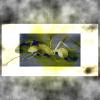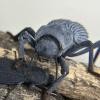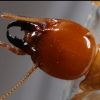Fly larva with a fake termite face can infiltrate termite mounds and socialize
https://phys.org/new...infiltrate.html
[NOTE: These harvester termites collect grass and have working eyes]
On the back of the body, the larvae display a "termite mask": a non-functional "head" with antennae and palps the same size as those of a large harvester termite. They also have two false eyes, which are actually the larvae's breathing holes.
In addition, the larvae have unusual "tentacles" around their bodies that mimic termite antennae in great detail, which the team was able to demonstrate using scanning electron microscopy. The numerous tentacles surrounding the body of the larvae facilitate simultaneous communication with several termites.
These maggots ... also manage to mimic the distinctive odor of their hosts.
-
Stubyvast, Voidley, AntsGodzilla and 1 other like this
Past & Present
Veromessor pergandei, andrei, stoddardi; Novomessor cockerelli
Camponotus fragilis, Camponotus sansabeanus (inactive), vicinus, laevigatus/quercicola, CA02
Pogonomyrmex subnitidus, P. californicus (inactive)
Liometopum occidentale (inactive); Prenolepis imparis; Myrmecocystus mexicanus (inactive); Tetramorium sp. (inactive); Lasius sp.
Termites: Zootermopsis angusticollis, and a box of drywood termites that can't be seen
Isopods: (most no longer keeping) A. gestroi, granulatum, kluugi, maculatum, vulgare; C. murina; P. hoffmannseggi, P. haasi, P. ornatus; V. parvus, P. pruinosus, T. tomentosa
Spoods: (no longer keeping) Phidippus sp., other















